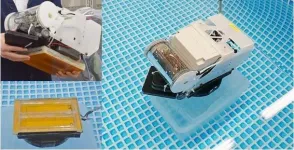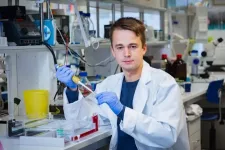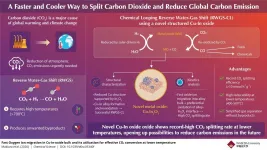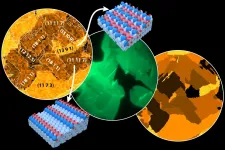(Press-News.org) Overview:
Associate professor Masaya Tamura, Kousuke Murai (who has completed the first term of his master's program), and their research team from the Department of Electrical and Electronic Information Engineering at Toyohashi University of Technology have successfully transferred power and data wirelessly through seawater by using a power transmitter/receiver with four layers of ultra-thin, flat electrodes. In the field of wireless power transfers, seawater behaves as a dielectric with extremely high loss, and achievement through capacitive coupling is difficult. Up until now, it had been thought that wireless power transfers could only be achieved through magnetic coupling. This time, with a focus on the high-frequency properties of seawater, a third method for conductive coupling was devised, and a power transmitter/receiver was developed to achieve highly-efficient power transfers.
Details:
The number of people involved in the Japanese fishing industry continues to decrease yearly as the average age increases. One reason for this is the large amount of high-intensity manual labor which has to rely on human hands. To improve this situation, automation is advancing through the use of robots that clean aquaculture nets, etc. In the future, it is expected that robots (underwater drones) will be developed that are stationed in seawater so that water quality and environmental management, checks on fish growth, etc., can all be managed robotically. However, because these drones are battery-powered, it is necessary to pull them out of the water, charge them, and have them dive back into the water repeatedly. Additionally, the data collected underwater must be collected at this time. The key to this problem is the development of technology to wirelessly transfer power and data in seawater through a power supply station. In particular, as these drones are lightweight, and because increasing the weight and volume makes controlling buoyancy and orientation difficult, technology that is lightweight and space-conserving must be realized. Associate professor Masaya Tamura and his team of researchers have developed a new type of electric transmitter/receiver that achieves highly-efficient wireless power transfers even in seawater.
The efficiency of the wireless power transfer depends on the kQ product, which is the product of the coupling coefficient k between the power transmitter and receiver and the Q-factor of the power transmitter/receiver loss including the influence of the surrounding environment. Efficiency improves as k approaches 1 and the Q-factor increases. However, high-frequency electric current flows in highly conductive dielectrics like seawater, making it difficult to discuss k and the Q-factor in isolation. However, because the principle whereby efficiency improves as the kQ product increases does not change, key parameters were identified for improving efficiency from an equivalent circuit that focused on the conductivity of seawater from the viewpoint of the kQ product. A design theory was then established wherein the kQ product indicated the maximum value, and the power transmitter/receiver was designed. Based on this, an RF-RF power transfer efficiency of 94.5% at a transfer distance of 2 cm and of at least 85% at a transfer distance of 15 cm was achieved across a wide band. A power transfer efficiency of at least 90% can even be maintained at a transfer distance of 2 cm with 1 kW of electric power. Moreover, high-speed transfers can be achieved to maintain high efficiency across a wide band. The team was successful in using the electric transmitter/receiver that they developed to charge a capacitor and to use this power to drive a camera module that transferred video in real-time through the same electrical transmitter/receiver. The transfer speed this time was about 90 Mbps, but higher speeds are possible. Experiments to transfer power and data to a small underwater drone, with the expectation that the drone would park on the power supply station, were also successful. The total weight of the electrical receiver and electrical power circuit mounted on the drone at this time was very light at around 270 g.
Development Background:
The leader of the research team, associate professor Masaya Tamura, stated: "In ion-rich seawater, it was expected that high-frequency electric current would flow with minimal loss. When researching wireless power transfers in freshwater, and when analyzing the way power transfer efficiency changed with the salinity of the water, we encountered a phenomenon where efficiency would decrease by a few percent as the salinity increased, but from a certain salinity, the efficiency would recover and be maintained at about 20%. I firmly believed that this was evidence substantiating my prediction, and we developed an operational theory from an equivalent circuit for a power transmitter/receiver to investigate and clarify these results in detail. We then designed the structure of the power transmitter/receiver based on that theory, and after creating the prototype and performing the measurements, we obtained results for a power transfer in seawater with an efficiency of at least 90%. To prevent chemical changes to the surface of the electrodes that occur in seawater when large amounts of power are supplied, an insulated coating was applied. We were surprised to achieve efficiency of at least 90% even under these conditions."
Future Outlook:
The research team believes that these research results will allow drones to transfer data and be recharged in seawater without significant design changes to underwater drones, and that they will contribute to rapid improvements in operational efficiency. The power transmitter/receiver that was developed is very simple and lightweight, meaning that the increase in weight for underwater drones can be minimized. Their ultimate goal is to contribute to the development of underwater drone systems that can be entirely managed on land. The results of this research are planned to be announced in the future in publication, at academic conferences, etc.
INFORMATION:
Reference:
Masaya Tamura, Kousuke Murai, Marimo Matsumoto, "Design of Conductive Coupler for Underwater Wireless Power and Data Transfer," IEEE Transaction on Microwave Theory and Techniques, vol. 69, no. 1, pp.1161-1175, Jan. 2021, doi: 10.1109/TMTT.2020.3041245. (Early Access)
This work was supported in part by the Japan Society for the Promotion of Science (JSPS) Grants-in-Aid for Scientific Research (KAKENHI) JP18K04262.
Researchers from the University of Seville and the University of Pavia have identified a link between Amyotrophic Lateral Sclerosis (ALS) and the accumulation of DNA-RNA hybrids in the genome. The accumulation of these hybrids causes increased genomic damage and boosts genetic instability. This finding will make it possible to better understand the molecular basis of the disease, as well as to propose new solutions to curb it.
Amyotrophic Lateral Sclerosis (ALS) is a neurodegenerative disease of the central nervous system, characterised by progressive degeneration ...
The descendants of regular wild-type bacteria can evolve to survive for a long time on metallic copper surfaces that would usually kill them within a few minutes. An international research team led by Martin Luther University Halle-Wittenberg (MLU) and the Bundeswehr Institute of Microbiology was able to produce these tiny survivalists in the lab and has been able to study them more closely. The team reports on its findings in Applied and Environmental Microbiology.
Bacterial infections are usually treated with antibiotics. However, in recent decades many pathogenic bacteria have developed an increasing tolerance to common drugs. So-called multidrug-resistant bacteria are of particular concern as ...
It is politically agreed and necessary for climate protection reasons that our entire economy becomes climate-neutral in the coming decades - and that applies to air travel, too. This is a technically feasible goal, and there are numerous ways to achieve it. ETH Professor Marco Mazzotti and his team have now compared the options that appear to be the easiest to implement in the short and medium term and evaluated them according to factors such as cost-effectiveness.
The ETH researchers conclude that the most favourable option is to continue powering aircraft with fossil fuels in future, but then remove the associated CO2 emissions from the atmosphere ...
Fuchs' corneal dystrophy is one of the most common eye diseases diagnosed in almost 5% of the population of Europe aged 40 years or over. It is a hereditary eye disease that causes vision impairment and typically manifests in middle age. The first symptoms of the disease - blisters on the surface of your cornea - resemble cataract at first glance. The disease progresses from the centre of the cornea affecting all layers of the cornea. The progression of the disease varies from individual to individual and in severe cases results in vision loss.
The molecular neurobiology ...
With ever-worsening climate change, there is a growing need for technologies that can capture and use up the atmospheric CO2 (carbon dioxide) and reduce our carbon footprint. Within the realm of renewable energy, CO2-based e-fuels have emerged as a promising technology that attempts to convert atmospheric CO2 into clean fuels. The process involves production of synthetic gas or syngas (a mixture of hydrogen and carbon monoxide (CO)). With the help of the reverse water-gas shift (RWGS) reaction, CO2 is broken down into the CO necessary for syngas. While promising in its conversion efficiency, the RWGS reaction requires incredibly high temperatures (>700°C) to proceed, while also generating ...
In a new study, researchers at Karolinska Institutet in Sweden have used a urine test to identify and verify a patient's type of asthma. The study, which has been published in the American Journal of Respiratory and Critical Care Medicine, lays the foundation for a more personalized diagnosis and may result in improved treatment of severe asthma in the future.
About 10 percent of the Swedish population suffers from asthma, a disease that has become increasingly widespread over the past 50 years, with annual global mortality of around 400,000 according to the World Health Organization. Asthma is characterized by chronic inflammation in the airways, which can result in symptoms including ...
In three recent publications in Molecular Psychiatry, Brain and JAMA Neurology researchers from the University of Gothenburg provide convincing evidence that an in-house developed blood test for Alzheimer's disease can detect the disease early and track its course, which has major implications for a potential use in clinical practice and treatment trials.
"This is an extremely dynamic research field right now, thanks to the technological development and seminal scientific progress in the past years. The dream scenario is to have a blood test for the early detection and screening of Alzheimer's disease up and running. That would give significantly ...
Workaholism or work addiction risk is a growing public health concern that can lead to many negative mental and physical health outcomes such as depression, anxiety or sleep disorder. Perception of work (job demands and job control) may become a major cause of employees' work addiction. The international group of researchers including the HSE University scientist explored the link between work addiction risk and health-related outcomes using the framework of Job Demand Control Model. The results were published in the International Journal of Environmental Research and Public Health.
Workaholics are people who usually work seven and more hours more than ...
Optical sensors can quantitatively analyze chemical and biological samples by measuring and processing the optical signals produced by the samples. Optical sensors based on infrared absorption spectroscopy can achieve high sensitivity and selectivity in real time, and therefore play a crucial role in a variety of application areas such as environmental sensing, medical diagnostics, industrial process control and homeland security.
In a new paper published in Light: Science & Applications, a team of scientists, led by Dr. Peter Q. Liu from the Department of Electrical Engineering, the State University of New York at Buffalo, have demonstrated a new type of high-performance optical sensor which can utilize ...
Metal surfaces play a role as catalysts for many important applications - from fuel cells to the purification of car exhaust gases. However, their behaviour is decisively affected by oxygen atoms incorporated into the surface.
This phenomenon has been known for a long time, but until now it has not been possible to precisely investigate the role of oxygen in complex surfaces point by point in order to understand the chemical background at the atomic level. This has now been achieved at TU Wien in cooperation with a team from the Elettra Synchrotron in Trieste. It became possible ...







